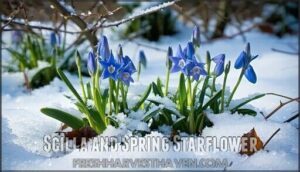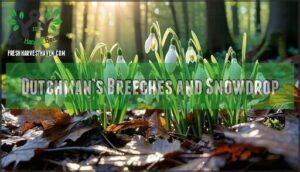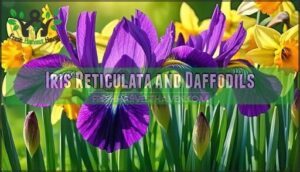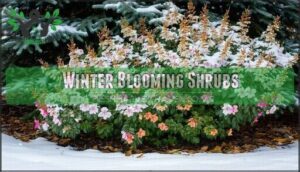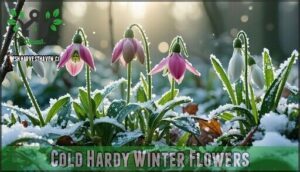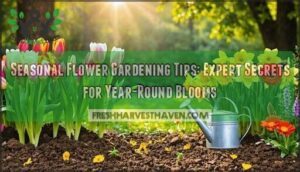This site is supported by our readers. We may earn a commission, at no cost to you, if you purchase through links.
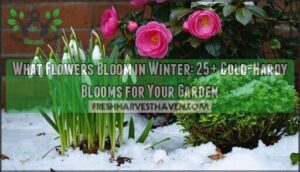 You’ll find plenty of flowers that bloom in winter, defying the cold with surprising resilience.
You’ll find plenty of flowers that bloom in winter, defying the cold with surprising resilience.
Early bulbs like snowdrops, crocuses, and winter aconites push through snow as early as February. Hardy shrubs such as witch hazel, winter jasmine, and camellias provide vibrant color during the darkest months.
Perennials like hellebores and cyclamen actually prefer cooler temperatures, blooming reliably when other plants rest. Even some bulbs like amaryllis and certain daffodil varieties can bloom indoors or in protected spots.
These winter champions prove your garden doesn’t have to hibernate completely. The secret lies in choosing the right varieties and understanding their specific cold tolerance levels to ensure a thriving garden throughout the year, with vibrant color and surprising resilience.
Table Of Contents
- Key Takeaways
- Winter Blooming Flowers
- Flowers That Bloom in Winter
- Winter Blooming Bulbs
- Winter Blooming Shrubs
- Cold Hardy Winter Flowers
- Frequently Asked Questions (FAQs)
- What flowers can still bloom in the winter?
- What is the most common winter flower?
- Which one of the following flowers blooms in winter?
- What wild flowers bloom in winter?
- What flower is in season in December?
- What is the first flower to bloom in the winter?
- Which flower is Queen of winter?
- Can winter flowers survive freezing temperatures?
- What care do winter flowers usually require?
- Are there fragrant flowers that bloom in winter?
- Conclusion
Key Takeaways
- You’ll find plenty of hardy options – Early bulbs like snowdrops, crocuses, and winter aconites push through snow, while shrubs like witch hazel and camellias provide vibrant color during winter’s darkest months.
- Choose plants that actually prefer cold – Hellebores, cyclamen, and winter jasmine don’t just survive freezing temperatures – they thrive in them, often producing their best blooms when other plants stay dormant.
- You can create year-round garden interest – By selecting the right varieties and understanding their cold tolerance levels, you’ll maintain continuous color and fragrance throughout winter instead of accepting a barren landscape.
- Many winter bloomers require minimal care – Most cold-hardy flowers need only proper drainage, wind protection, and moderate watering during dry spells, making them low-maintenance additions to your winter garden.
Winter Blooming Flowers
You can brighten your winter garden with flowers that actually thrive in cold weather, from cheerful crocuses pushing through snow to elegant camellias blooming despite frost.
Transform your winter landscape into a magical display when nature’s dormant season reveals its most resilient blooms.
These hardy plants don’t just survive winter—they put on their best show when temperatures drop, giving you color and fragrance when you need it most.
Amaryllis and Calendula
During winter’s quiet months, Amaryllis varieties like ‘Red Lion’ and ‘Apple Blossom’ bring trumpet-shaped blooms indoors.
These winter blooming flowers need 8-10 weeks of dormancy before their spectacular bloom time.
Calendula uses extend beyond ornamental appeal—their edible petals brighten winter salads.
For winter care, keep Amaryllis at 60-70°F with bright light.
Calendula tolerates light frost outdoors.
Both flowers that bloom in winter make excellent companion plants with evergreen foliage.
Crocus and Glory of The Snow
Crocus bulbs burst through snow with cup-shaped flowers in purple, yellow, and white.
These hardy bulbs thrive in full sun, zones 3-8, attracting early pollinators.
Plant in fall for late winter blooms.
Glory of the Snow produces star-shaped periwinkle blue flowers, multiplying annually in part sun conditions, creating stunning ground cover displays with early pollinators.
Snowdrops and Winter Aconite
While crocus add cheerful color to late winter, snowdrops and winter aconite bring their own magic to cold gardens.
These hardy winter blooming flowers create stunning displays when snow still blankets the ground, making them essential winter garden flowers for any landscape.
- Snowdrops: Small white bell-shaped flowers with green markings that emerge through snow, blooming January-March in hardiness zones 3-7
- Winter Aconite: Bright yellow buttercup-like flowers with green collars that tolerate snow, blooming February-March in zones 4-7
- Ecology: Both attract early pollinators and naturalize easily, with snowdrops multiplying by offsets and winter aconite self-seeding
- Toxicity: Winter aconite is toxic to humans and pets, requiring careful placement away from children and animals
- Companion Plants: Pair with hellebores, early crocuses, and evergreen shrubs for extended winter interest and layered blooming periods
Cyclamen and Lenten Rose
Your garden’s winter stars, Cyclamen and Lenten Rose, offer remarkable beauty during cold months.
These hardy perennials thrive in different conditions but share exceptional winter hardiness and extended bloom time.
| Feature | Cyclamen | Lenten Rose |
|---|---|---|
| Bloom Colors | Pink, white, red, purple | White, pink, purple, speckled |
| Light Needs | Bright indirect light | Partial to full shade |
| Hardiness Zones | 5-8 | 4-8 |
| Companion Plants | Primrose, winter jasmine | Snowdrops, winter aconite |
Cyclamen varieties flourish indoors and outdoors, while Lenten Rose care requires well-draining soil and patience—it’s a slow starter but long-lived performer in your winter bloom guide.
Many find that plant interaction reduces stress.
Flowers That Bloom in Winter
Cold-hardy blooms transform your landscape when most plants retreat into dormancy.
These resilient flowers that bloom in winter prove that nature’s beauty doesn’t pause for frost. Winter flowering plants adapt to harsh conditions through specialized mechanisms like antifreeze compounds and protective waxy coatings. Many winter season flowers actually require cold temperatures to trigger their blooming cycles, making them perfectly suited for Colorful Winter Gardens.
Here are five standout winter flower names for your garden:
- Hellebore (Christmas Rose) – Cup-shaped blooms in white, pink, and purple that emerge through snow
- Pansies – Heart-shaped petals with vibrant colors and distinctive dark markings
- Primrose – Bright clusters in red, yellow, blue, and pink that multiply over time
- Viola – Edible flowers that bloom fall through spring in warmer climates
- Winter Jasmine – Cheerful yellow trumpet-shaped flowers on trailing branches
These cold weather flowers require minimal Winter Bloom Care while providing maximum impact. Many offer Fragrant Winter Blooms that serve dual purposes: Winter Flower Meanings often symbolize hope and renewal, while also Attracting Pollinators during scarce months.
Winter Blooming Bulbs
Winter bulbs transform your garden into a colorful display when most plants stay dormant.
Winter bulbs awaken your garden when the world sleeps, creating magical displays through snow and frost.
You’ll find these hardy bloomers push through snow and frost to deliver early spring flowers that signal winter’s end.
Scilla and Spring Starflower
Planting Scilla and Spring Starflower brings early winter color to your garden.
These hardy bulbs push through snow, creating magical displays when everything else sleeps. They’re perfect companion plants for naturalizing areas.
Discover more about different Scilla bulb types for your garden.
| Aspect | Scilla | Spring Starflower |
|---|---|---|
| Bloom Color | Blue, purple, white | Pale blue, white |
| Fragrance | None | Sweet scent |
| Sun Requirements | Partial shade | Full sun to partial shade |
| Propagation | Bulb division | Self-seeding |
| Winter Care | Minimal | Drought tolerant |
Both winter flowering plants require well-drained soil and minimal maintenance.
Plant bulbs in fall for late winter blooms.
These winter flowers multiply naturally, creating stunning drifts over time.
Dutchman’s Breeches and Snowdrop
Through winter’s coldest months, Dutchman’s Breeches and Snowdrops emerge as treasured Spring Ephemerals, offering hope when most gardens sleep.
These Woodland Companions naturalize beautifully, with Snowdrops multiplying through Bulb Division and self-seeding.
Naturalizing Snowdrops creates stunning drifts, while Dutchman’s Breeches adds unique heart-shaped blooms.
Both winter bloomers have low Toxicity Levels but require careful handling, making them perfect winter flowers types for experienced gardeners, particularly those who appreciate Woodland Companions.
Iris Reticulata and Daffodils
Iris Reticulata varieties burst forth in late winter, showcasing deep purple blooms with golden markings.
These miniature bulbs thrive in well-drained soil and complement early daffodil cultivars perfectly. Plant both bulbs together following standard planting guide depths for stunning winter garden displays.
Their overlapping bloom times create spectacular companion plants arrangements, while Iris unguicularis extends the winter flowers season into spring.
To help reduce stress during the winter months, consider therapeutic effects of caring for indoor plants, which can have a positive impact on mental health and provide beautiful blooms.
Winter Blooming Shrubs
Winter-blooming shrubs transform bare landscapes into stunning displays of color and fragrance during the coldest months.
You’ll find these hardy performers bloom reliably from December through March, offering essential beauty when most other plants remain dormant, and they provide a necessary splash of color.
Camellia and Daphne
You’ll find these winter blooming shrubs transform your garden into a colorful sanctuary during the coldest months. Camellia varieties offer stunning rose-like blooms in vibrant pinks, reds, and whites, while their evergreen foliage provides year-round structure.
Daphne fragrance fills the air with sweet perfume from delicate clusters of winter-blooming flowers, making these fragrant flowers perfect companions for winter flower types requiring acidic soil and careful winter care. Notably, plants like these can provide stress reduction benefits through interaction.
- Camellia thrives in acidic soil with partial shade, blooming from fall through winter with glossy leaves that stay green year-round
- Daphne produces intensely fragrant clusters of small white or pink flowers that can perfume an entire garden corner
- Both shrubs prefer protected locations with well-draining soil and benefit from mulching to protect roots during harsh weather
Mahonia and Pieris
Mahonia and Pieris transform your winter garden into a vibrant wonderland. These evergreen shrubs offer stunning foliage contrast—Mahonia’s spiky leaves against Pieris’s glossy green foliage that emerges red in spring.
Both require acidic, well-drained soil and partial shade for ideal growth.
| Feature | Mahonia | Pieris |
|---|---|---|
| Bloom Time | Winter | Late winter to early spring |
| Flower Color | Bright yellow clusters | White to pink bells |
| Special Notes | Attracts early pollinators, deer-resistant | Toxic if ingested, susceptible to leaf spot |
| Wildlife Value | Berries feed birds | Attracts bees |
| Maintenance | Low maintenance | Requires pruning for shape |
Mahonia varieties include Oregon grape, while Pieris toxicity makes it unsuitable near children or pets. These companion plants create year-round interest in your winter flowering shrubs collection.
Consider purchasing Mahonia to enhance your garden. Care tips include regular watering during establishment and mulching for winter protection.
Winter Heath and Witch Hazel
Purple blooms and fragrant petals make winter heath (Erica) and witch hazel (Hamamelis) standout winter flowering shrubs.
Winter heath produces colorful blooms from December through February, attracting pollinators with its mounding growth habit.
Witch hazel offers exceptional winter fragrance through spidery flowers in orange, red, or yellow.
Sourcing winter heath is easy online.
Proper garden placement guarantees these heather family members thrive in your winter garden landscape.
Oregon Grape and Arrowwood Dawn
Oregon Grape and Arrowwood Dawn bring exceptional winter interest to your garden through their unique flowering patterns.
Oregon Grape produces dense clusters of bright yellow flowers in early spring, followed by dark bluish-black Mahonia berries that provide wildlife attraction.
Arrowwood Dawn offers scented pink blossoms on bare stems from late autumn through early spring, creating stunning Viburnum scent throughout winter months.
- Oregon Grape blooms: Bright yellow flower clusters emerge in late winter, contrasting beautifully with spiky evergreen foliage
- Arrowwood Dawn fragrance: Pink blossoms release sweet Viburnum scent on naked stems for months of sensory appeal
- Wildlife benefits: Mahonia berries attract birds while flowers provide early nectar sources for pollinators
- Shrub comparison: Oregon Grape stays compact (3-6 feet) while Arrowwood Dawn reaches 6-10 feet with spreading habit
- Winter garden value: Both winter flowering shrubs offer structural interest and color when most plants remain dormant
Cold Hardy Winter Flowers
Cold-hardy winter flowers bring life to your garden when most plants lie dormant. These resilient bloomers withstand freezing temperatures and snow, offering color and fragrance during the coldest months.
Winter Jasmine and Cornelian Cherry
Winter jasmine brightens dreary months with cheerful yellow trumpet-shaped flowers on trailing branches.
This hardy shrub thrives in zones 4-9, requiring minimal winter care.
Cornelian cherry dogwood produces clusters of small yellow fragrant flowers before leaves emerge.
Both make excellent companion plants for early spring color, and these winter blooming flowers add essential structure to your winter garden landscape, providing cheerful yellow blooms.
Chinese Lantern Tree and Grevillea
Chinese Lantern Tree and Grevillea showcase exotic winter blooms that transform your winter garden into a vibrant display.
These winter flowering shrubs offer unique flower shapes and tropical winter color while attracting pollinators during colder months.
Here’s what makes these winter blooming flowers perfect for winter garden design:
- Chinese lantern tree produces distinctive bi-colored lantern-like flowers in pink and yellow combinations
- Grevillea displays spider-like or toothbrush-shaped blooms in vibrant red, pink, or orange colors
- Both species demonstrate excellent drought tolerance and adapt well to poor soil conditions
- These plants provide essential nectar sources for birds, bees, and butterflies during winter months
To maximize visual impact, consider their strategic plant placement.
Winter Peony and Mediterranean White Heather
While winter peonies require mild winters to produce their large, lush blooms in pink, red, or white, Mediterranean white heather thrives in colder conditions with its delicate bell-shaped flowers.
Both plants offer unique fragrance profiles that enhance winter garden design, with consistent winter blooms from heather varieties being more reliable than winter peonies in harsh climates.
These winter-blooming flowers create stunning focal points when planted strategically throughout your winter garden landscape, and considering heather varieties can help achieve this goal.
Frequently Asked Questions (FAQs)
What flowers can still bloom in the winter?
Nearly 50% of flowering plants can adapt to bloom during winter months, defying harsh conditions. You’ll find camellias, hellebores, pansies, and witch hazel brightening cold landscapes with colorful blooms.
What is the most common winter flower?
Hellebores, often called Christmas roses, are the most common winter bloomers you’ll find in gardens.
They’re hardy perennials that thrive in cold weather and produce cup-shaped flowers in white, pink, purple, or green throughout winter’s darkest months, making them a notable winter bloomer.
Which one of the following flowers blooms in winter?
You’ll find several flowers that bloom during winter months, including camellias, pansies, hellebores, cyclamen, and winter jasmine.
These hardy plants bring color and fragrance to gardens when most other flowers are dormant, making them a valuable addition to any winter garden with fragrance.
What wild flowers bloom in winter?
You’ll discover hellebores, winter aconite, and snowdrops blooming naturally in woodlands. These hardy wildflowers push through snow and frost, creating delicate displays when most plants sleep through winter’s chill.
What flower is in season in December?
Like candles flickering against winter’s darkness, December’s blooms defy the cold.
You’ll find camellias opening their rose-like petals, hellebores emerging as "Christmas roses," and cyclamen brightening indoor spaces with upswept flowers.
What is the first flower to bloom in the winter?
Winter aconite typically blooms first, often pushing through snow in late winter.
You’ll also see early crocuses, snowdrops, and hellebores appearing around the same time, bringing cheerful yellow and white blooms to your garden, with hellebores being a notable addition.
Which flower is Queen of winter?
Camellia earns the title "Queen of Winter" for its stunning rose-like blooms in pink, red, white, and variegated shades.
You’ll find these evergreen beauties flowering throughout winter’s coldest months, providing regal color when most plants rest.
Can winter flowers survive freezing temperatures?
Many winter flowers can’t survive true freezing temperatures, but some hardy champions like hellebores, snowdrops, and winter aconites actually thrive in cold conditions.
They’ve developed antifreeze-like compounds in their cells that prevent ice crystal formation, allowing them to bloom even through frost.
What care do winter flowers usually require?
You’ll need to provide proper drainage, protect from harsh winds, and water moderately during dry spells. Most winter bloomers prefer partial shade and well-draining soil to prevent root rot.
Are there fragrant flowers that bloom in winter?
Yes, several fragrant flowers bloom in winter.
Witch hazel produces spicy-scented, spider-like flowers in yellow, orange, or red.
Daphne offers highly fragrant white or pink clusters.
Winter honeysuckle has sweet-scented creamy blooms that attract pollinators effectively.
Conclusion
A garden without flowers is like a sky without stars" – and fortunately, you don’t need to settle for a barren winter landscape.
Understanding what flowers bloom in winter transforms your garden from dormant to dazzling during the coldest months.
From early bulbs like snowdrops to hardy shrubs like witch hazel, these cold-tolerant varieties provide continuous color and interest.
You’ll discover that winter gardening isn’t about surviving the season – it’s about embracing plants that actually thrive in cooler temperatures, ensuring your outdoor space remains vibrant year-round, with continuous color and dazzling beauty.

